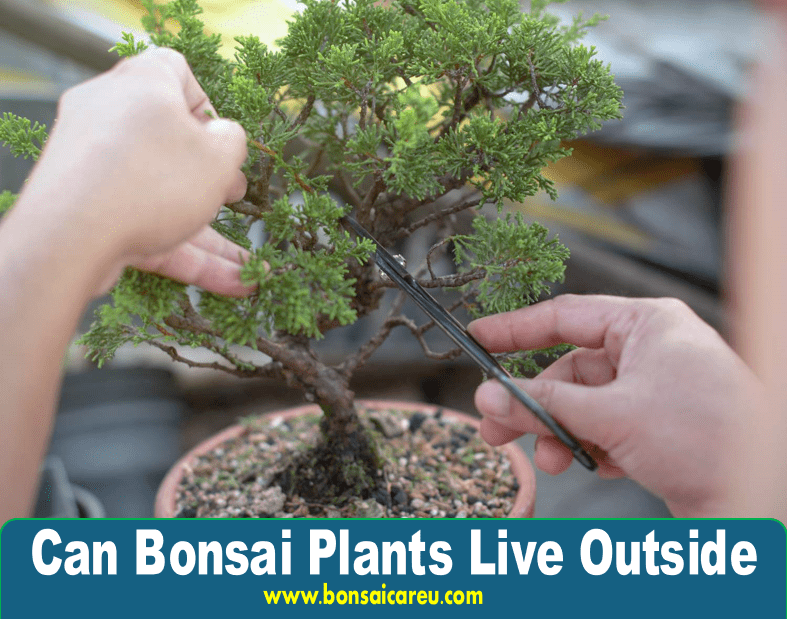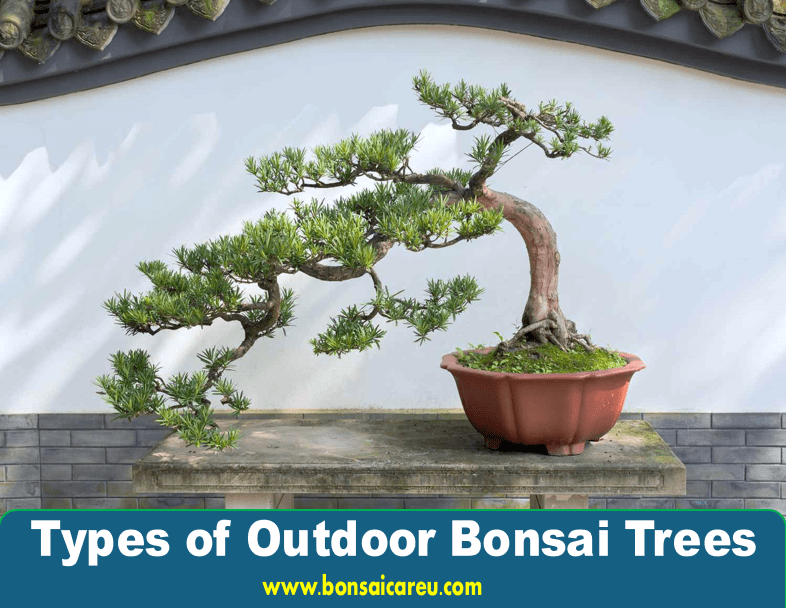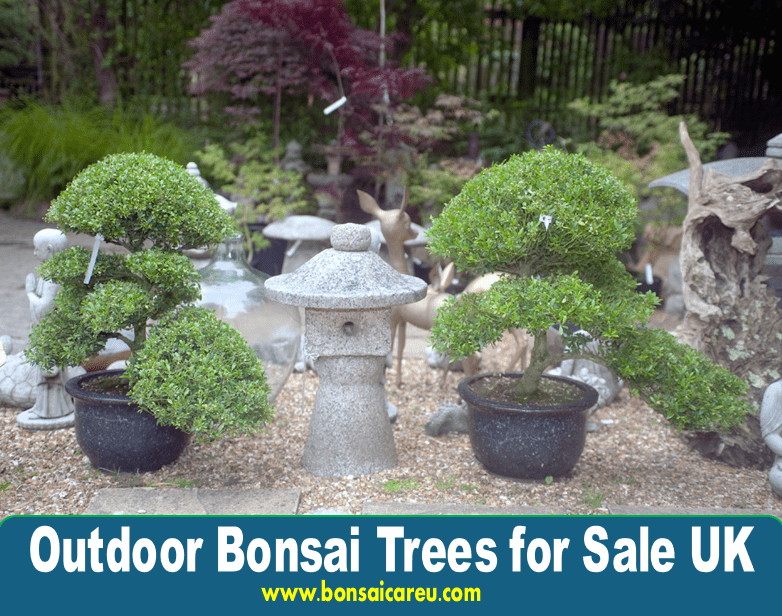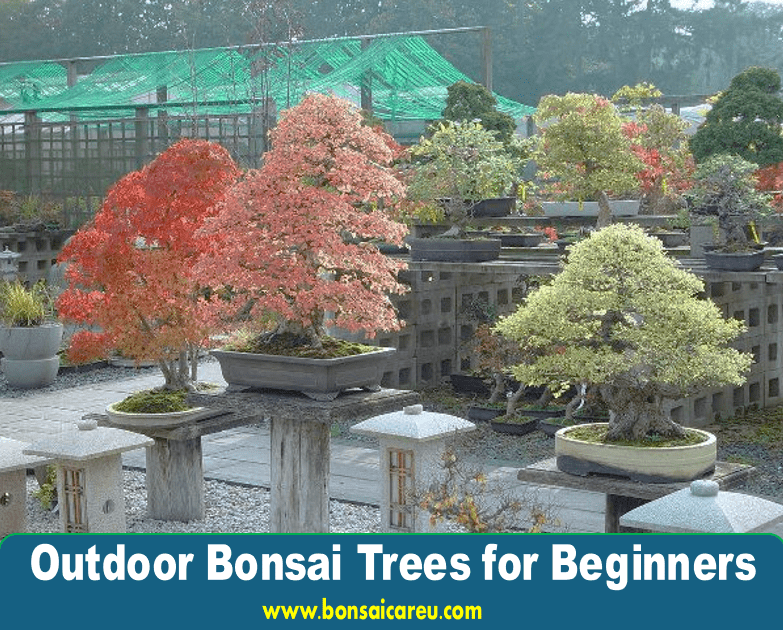Can Bonsai Plants Live Outside: Bonsai plants can live outside, but they need sunlight for a few hours daily. Outdoor Bonsai trees require proper care to thrive and should be protected from extreme weather conditions.
Providing the right amount of sunlight and ensuring adequate watering is essential for the health of outdoor Bonsai plants. While some Bonsai species can be kept indoors year-round, most trees benefit from being placed outside to experience the natural seasonal changes.
Understanding the specific needs of your Bonsai plant and following proper care guidelines will help it flourish outdoors. By taking the necessary precautions and providing appropriate care, you can enjoy the beauty of Bonsai plants indoors and outdoors.

Bonsai Basics: Nature’s Miniature Wonders
Bonsai, the art of cultivating miniature trees, is a captivating practice that brings nature’s beauty into a compact form. One common query among bonsai enthusiasts is whether these enchanting plants can thrive outside. Let’s explore the art of bonsai and the characteristics of healthy bonsai to understand their potential for outdoor living.
The Art Of Bonsai
Bonsai, originating from the Chinese term “penzai,” involves the cultivation of small trees in shallow containers, meticulously pruned and shaped to mimic the appearance of full-sized trees. The goal is to create a harmonious and balanced representation of nature in a miniature form.
Characteristics Of Healthy Bonsai
- Proper Sunlight: Outdoor bonsai trees require adequate sunlight exposure for at least a few hours daily to thrive. Insufficient light can lead to oversized leaves and internodes, making the plant susceptible to pests and diseases.
- Genetic Adaptation: Hardy outdoor bonsai trees are genetically suited to withstand harsh winter conditions, making them resilient to frost and low temperatures.
- Protection from Elements: While outdoor living is suitable for many bonsai trees, it is essential to shield them from strong winds and abrupt temperature changes, especially during winter, to ensure their well-being.
In conclusion, the art of bonsai offers a glimpse into the intricate beauty of nature, allowing enthusiasts to create miniature wonders. Understanding the characteristics of healthy bonsai is crucial for their successful outdoor cultivation, ensuring their resilience and longevity.
Outdoor Bonsai Placement
Bonsai plants can live outside, but they require proper care and attention. Outdoor bonsai should be placed in an area where they can get at least a few hours of sunlight each day. It is important to protect them from strong winds and sudden temperature drops and to water them regularly.
Sunlight Requirements
One of the key factors to consider when placing your bonsai outside is sunlight. Most outdoor bonsai trees require at least a few hours of sunlight daily. Without adequate sunlight, the internodes and leaves will grow too large, making the tree more susceptible to pests and diseases. For healthy growth, most conifers should be placed in full sun.
Protecting From Extreme Weather
While outdoor bonsai trees are generally hardy and can withstand low temperatures, protecting them from extreme weather conditions is still important. Strong winds can cause damage to the tree or even uproot it, so it’s best to place it on the ground and protect it from wind. Sudden temperature drops can also be harmful, so consider covering the bonsai pot with a bed sheet or other insulation.
Ensuring Adequate Care
Proper care is essential for the health and longevity of your outdoor bonsai tree. This includes regular watering, fertilizing, and pruning. Remember that the more sunlight and warmth the tree receives, the more often it will need water. Additionally, pests and diseases can be a problem for outdoor bonsai trees, so watch for any signs of infestation and take appropriate action. In conclusion, outdoor bonsai placement requires careful consideration of sunlight requirements, protection from extreme weather, and proper care. With these factors in mind, you can enjoy the beauty of a thriving outdoor bonsai tree in your garden.
Seasonal Bonsai Care
Proper care for your bonsai varies depending on the season. Understanding the seasonal needs of your bonsai is crucial to ensure its health and longevity.
Summer Care
- Place outdoor bonsai trees where they can receive sunlight for a few hours daily.
- Ensure proper watering, as increased heat can cause the soil to dry out quickly.
- Regularly prune and shape your bonsai to maintain its desired form.
Winter Protection Strategies
- Winter outdoor bonsai trees need protection from strong winds and sudden temperature drops.
- Consider placing your bonsai on the ground for added insulation.
- Cover the pots with a bed sheet or other material to shield them from extreme cold.
The Right Environment For Bonsai
Bonsai plants can live outside but need the right environment to thrive. Most outdoor bonsai trees require several hours of sunlight daily to prevent excessive growth and susceptibility to pests and diseases. Protecting them from strong winds and sudden temperature drops is also essential, especially during the winter months.
Choosing The Best Location
Bonsai plants thrive in environments that mimic their natural habitats, so choosing the right location is crucial for their well-being. When placing your bonsai outside, ensure it receives adequate sunlight, typically at least a few hours a day. Consider placing it with morning sun and afternoon shade to prevent the leaves from getting scorched.
Understanding Your Local Climate
It’s essential to understand the climate of your local area when deciding to keep your bonsai plant outside. Different species of bonsai have varying temperature and humidity requirements, so be sure to select species that are well-suited to your region’s climate. Some bonsai trees are hardy enough to withstand even the lowest temperatures in winter, while others may require special protection or overwintering indoors.
Common Myths About Bonsai Trees
Several myths and misconceptions have been perpetuated over time when it comes to the art of growing bonsai trees. Debates about whether bonsai plants can thrive indoors or outdoors and misconceptions about their size and growth have led to confusion among enthusiasts. Let’s debunk some of the most common myths surrounding bonsai trees.
Indoor Vs Outdoor Debate
The common misconception is that bonsai trees can only thrive indoors, but this is not entirely true. While certain bonsai species can indeed thrive indoors, many others fare better when grown outdoors. It is important to consider the specific needs of each tree species and provide the appropriate environmental conditions for their optimal growth. Some bonsai trees require ample sunlight and fresh air, making them better for outdoor cultivation.
Size And Growth Misconceptions
Another prevalent myth about bonsai trees relates to their size and growth. Many believe bonsai trees are stunted or genetically modified to remain small. In reality, bonsai trees are not a specific species but regular trees and shrubs cultivated and pruned to maintain their miniature size. With proper care and maintenance, bonsai trees can live just as long as their full-sized counterparts.
Bonsai Longevity And Health
Bonsai plants can live outside, but it’s important to ensure they receive adequate sunlight for a few hours each day. Exposure to the four seasons is beneficial, but protecting them from strong winds and sudden temperature drops is essential for their health and longevity.
Regular watering and proper care are also crucial for outdoor bonsai trees.
Ensuring Proper Growth
Outdoor Bonsai trees require sunlight for a few hours daily to prevent issues. Most conifers thrive in full sun for optimal growth.
Dealing With Pests And Diseases
Protect your trees from strong winds, place them on the ground to avoid sudden temperature changes, and consider covering the pots with insulation.

Frequently Asked Questions For Can Bonsai Plants Live Outside
What Happens If You Plant A Bonsai Outside?
When planting a bonsai outside, ensure it gets enough sunlight daily to prevent overgrowth and disease susceptibility.
Can Bonsai Be Left Outside In Winter?
Yes, outdoor bonsai trees can withstand winter, as they are genetically adapted to frost and cold temperatures.
How Do I Protect My Bonsai Outside?
To protect your bonsai outside, place it on the ground to shield it from strong winds. Cover the pots with a bed sheet or insulation to prevent sudden temperature drops.
Can I Leave My Bonsai In The Sun?
Yes, bonsai trees need sunlight a few hours daily to stay healthy and avoid pests and diseases.
Can Bonsai Plants Thrive Outdoors?
Yes, outdoor bonsai trees need sunlight for a few hours daily to prevent issues and ensure healthy growth. Most conifers should be placed in full sun for proper development.
Can Bonsai Plants Survive Outdoors In Winter?
Outdoor bonsai trees from species that can withstand low temperatures should be fine. However, it’s best to avoid overwintering them outdoors, as protection from strong winds and sudden temperature drops is recommended.
Conclusion
It is vital to consider the specific needs of each bonsai tree species when deciding whether to place them outside. Providing adequate sunlight, protection from harsh elements, and proper care are key to their survival outdoors. Understanding these requirements will help your bonsai thrive in an outdoor environment.


